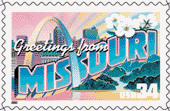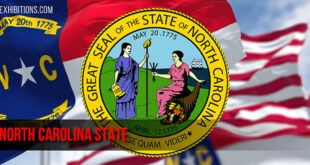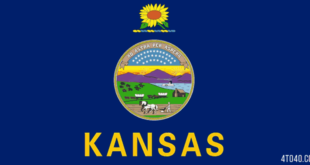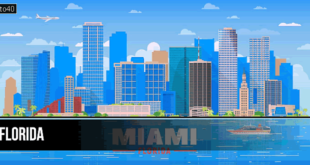 Missouri is a midwestern state of the United States, located near the country’s geographic center at the confluence of the two longest rivers in the United States–the Mississippi and the Missouri. Situated where North meets South and where the industrial East gives way to the plains of the West, Missouri exhibits characteristics of all these areas. It is bordered on the north by Iowa; on the east by Illinois, Kentucky, and Tennessee; on the south by Arkansas; and on the west by Nebraska, Kansas and Oklahoma. During the 19th century, Missouri served as a springboard for countless westward-bound settlers, and the state’s cities were long the westernmost outposts of U. S. civilization. Missouri, an Algonquian word meaning “people with big canoes,” was the name given to the Indians living near the mouth of the Missouri River.
Missouri is a midwestern state of the United States, located near the country’s geographic center at the confluence of the two longest rivers in the United States–the Mississippi and the Missouri. Situated where North meets South and where the industrial East gives way to the plains of the West, Missouri exhibits characteristics of all these areas. It is bordered on the north by Iowa; on the east by Illinois, Kentucky, and Tennessee; on the south by Arkansas; and on the west by Nebraska, Kansas and Oklahoma. During the 19th century, Missouri served as a springboard for countless westward-bound settlers, and the state’s cities were long the westernmost outposts of U. S. civilization. Missouri, an Algonquian word meaning “people with big canoes,” was the name given to the Indians living near the mouth of the Missouri River.
Land & Resources
 The terrain of Missouri varies from flat plains to rough hills. The lowest elevation, 70 m (230 ft), is along the Saint Francis River in the southeast, and the highest point, 540 m (1,772 ft), is Taum Sauk Mountain in the Saint Francois Mountains south of St. Louis.
The terrain of Missouri varies from flat plains to rough hills. The lowest elevation, 70 m (230 ft), is along the Saint Francis River in the southeast, and the highest point, 540 m (1,772 ft), is Taum Sauk Mountain in the Saint Francois Mountains south of St. Louis.
Physiographic Regions
Missouri has three major physiographic regions: the Ozark Highland, the Plains, and the Mississippi Alluvial Plain. The Ozark Highland has an average elevation of about 300 m (1,000 ft); it covers the southern portion of the state from St. Louis and Jefferson City on the Missouri River to Oklahoma and Arkansas. The region is famous for more than 5,000 caves and many large springs. One, Big Spring, in the south central part of the state, is among the largest springs in the United States. The Ozarks retain the rolling surface of a plateau near Springfield and in some of the central areas, but elsewhere swift-flowing streams have dissected the plateau, forming steep, narrow-crested hills. Relief reaches 230 m (750 ft) in the most rugged areas (see OZARK MOUNTAINS).
North and west of the Ozarks is the Plains region, rising gradually from 200 m (650 ft) near St. Louis to more than 380 m (1,250 ft) in the extreme northwest. During the past half-million years Pleistocene glaciers extended as far south as the Missouri River, covering northern Missouri with glacial till. Parts of the northeast are nearly flat, but in most places postglacial erosion by streams has resulted in hills and valleys. In a belt about 80 km (50 mi) wide along the Missouri River, the dissected plains are thickly mantled with loess. South of the Missouri River, along the Kansas border, the Osage Plains are more open and undulating.
The third major physiographic region, the Mississippi Alluvial Plain, or Bootheel, consists of the seven southeastern counties. The flat surface slopes slightly southward from the foot of the Ozark Escarpment.
Rivers and Lakes
The MISSISSIPPI and MISSOURI rivers dominate the state’s drainage system. The streams of northern Missouri flow generally southward across the till plain to these rivers. In southern Missouri streams flow away from the crest of the Ozark Highland in all directions. Ozark streams are fed by a complex network of underground drainage systems, and their discharge is relatively stable throughout the year.
Missouri’s largest lakes are artificial. The Lake of the Ozarks, formed by damming on the Osage River, is one of the world’s largest artificial lakes. Groundwater is abundant.
Climate
Missouri has a continental climate with hot, humid summers and cold winters. Because it lacks major topographical barriers, the state has a gradual climatic differentiation, warming from northwest to southeast. The clash of contrasting air masses in spring and fall may set off violent thunderstorms, some of which are accompanied by tornadoes.
The average January minimum temperatures range from -10 deg C (14 deg F) in the northwest to -1 deg C (30 deg F) in the southeast. July maximum temperatures average 33 deg C (92 deg F) throughout the state. Precipitation occurs throughout the year. Mean annual precipitation ranges from 813 mm (32 in) in the northwest to 1,270 mm (50 in) in the southeast. Average annual snowfall is 508 mm (20 in) in the northwest and 130 mm (6.5 in) in the southeast.
Historical Sites
A popular historical site in the state is the Gateway Arch in the Jefferson National Expansion Memorial. Designed by Eero SAARINEN, it is located on the original riverfront town site of St. Louis and symbolizes the city’s role as gateway to the West. The region surrounding HANNIBAL is closely associated with the life and work of Mark TWAIN. Saint Joseph was the eastern terminus of the famed but short-lived PONY EXPRESS. Sainte Genevieve preserves some of the best remaining examples of French Creole architecture in the Mississippi Valley.
Tourism
Tourist facilities are concentrated at the Lake of the Ozarks and in the White River region of the southwest. All of the Ozarks offer hiking, cave exploring, camping, boating, canoeing, fishing, and hunting. Many small Ozark communities are economically dependent on tourism.
History
Among the early Indian inhabitants of Missouri were MOUND BUILDERS, whose earthenwork monuments can be seen throughout the state. The most important regional tribes were the OSAGE, SAUK, FOX, and MISSOURI. Most had moved from the state by the time of European settlement.
European exploration began with the passage of Father Jacques MARQUETTE and the trader Louis JOLLIET down the Mississippi in 1673. In 1682 the Mississippi Valley was claimed for France by Robert Cavelier, sieur de LA SALLE, who named the territory Louisiana. The first permanent white settlement in what is now Missouri was made by the French at Sainte Genevieve in the 1740s.
French settlement in the 18th century was based on lead mining and fur trading, of which Saint Louis (founded 1764) became the center. France ceded the region to Spain in 1762, but Spanish control was never more than superficial. The Spanish did, however, permit settlement from east of the Mississippi, and by 1800 most of the new settlers were from Kentucky and Tennessee.
Spain retroceded the region to France in 1800, and in 1803 Missouri, along with the rest of the Louisiana territory, was sold to the United States (see LOUISIANA PURCHASE). Missouri was made a U.S. territory in 1812.
Statehood was achieved in 1821 by way of the MISSOURI COMPROMISE (1820), which permitted Missouri’s entry into the Union as a slave state. In 1837 the six northwestern counties were purchased from the Indians and added to the state by the Platte Purchase.
Because of its central location and its access to navigable rivers, Missouri served as the departure point for western trails and expeditions. The LEWIS AND CLARK EXPEDITION began near Saint Louis in 1804. The SANTA FE TRAIL opened a thriving trade with the Southwest in 1821, and the OREGON TRAIL, beginning in the 1830s and ’40s, was used by thousands of settlers to the Northwest. Both trails originated at Independence, Mo. Steamboat traffic on the Mississippi and Missouri rivers became important by the 1820s. Later access to the West took place via the overland Butterfield Trail, the pony express, and the railroads radiating from Saint Louis and Kansas City. The famous Missouri mule was specially bred for the arduous Santa Fe Trail.
Missouri was primarily a rural, agricultural state. In the Ozarks a subsistence farmer-woodsman economy, with Appalachian cultural traits, was established. The Boonslick district in the state’s center developed into the richest agricultural region, based in part on a small-scale slave plantation system.
The Civil War and Economic Growth
By the mid-19th century slavery was becoming uneconomical, and immigrants from free states and from Europe, especially Germany and Ireland, had modified the social structure. Nonetheless, slavery remained a controversial issue in the state. The case of DRED SCOTT V. SANDFORD, which reached the U.S. Supreme Court in 1856-57, began in Missouri. The moderate antislavery stance of Missouri’s longtime (1821-51) senator, Thomas Hart BENTON, cost him his political career.
Despite the strong block of proslavery sentiment, a Missouri state convention voted against secession in 1861. Several major Civil War battles took place in the state, however, and guerrilla fighting was bitter, bloody, and statewide. Violence continued after the war in the activities of such outlaws as Jesse JAMES. The state government was troubled by extremist groups immediately after the war, but stability was achieved in the 1870s.
After the Civil War, railroad building and the renewed westward movement of Americans encouraged industry and urban growth. Following a new influx of foreign immigrants, St. Louis grew to become the nation’s fourth-largest city in 1900.
Economic development in the West fostered Kansas City’s growth in agricultural and cattle-based industries. Missouri’s peak rural-farm population was reached in 1900. Its economic and social growth was depicted in the murals of Thomas Hart BENTON, grandnephew of the senator.
The 20th Century
In the period from 1880 to 1920 lumbering companies exhausted the best of the Ozark and Bootheel timber, and moved on to new territories. Many former employees turned to agriculture. In southeastern Missouri large-scale forest clearing, levee building, ditching, and draining of swamps encouraged cotton farming and attracted thousands of laborers, many of whom were black. The Tri-State Mining District, centered on Joplin, was the nation’s largest zinc-producing region, and the lead mines of the Saint Francois region boomed in the 1920s. Political power inexorably shifted from rural areas to the urban centers, as Missouri’s cities expanded in response to the growing economy. The Depression of the 1930s temporarily slowed economic growth, World War II further drained the rural work force, which left the farms in favor of employment in the cities. Industries continued to expand in the 1950s.
By the 1960s, however, depopulation of the inner part of each metropolitan area had begun. Urban deterioration lingers as one of the more intractable problems facing Missouri. Solutions are complicated by a fiscally conservative citizenry and by the fact that state boundaries transect the metropolitan areas of St. Louis and Kansas City.
In the early 1980s, Missouri also was faced with a major environmental challenge when dioxin contamination was discovered at Times beach, near St. Louis. A major cleanup program, expected to take about ten years, was begun in 1991.
Despite such problems Missouri agriculture has remained sound and efficient, and a vigorous program of road improvement has broken down the isolation of the Ozark crafts and folk culture. Missouri, because of its centrality in the nation and its diverse resources, remains attractive to manufacturing and commerce concerns as well, and it has attracted more than its share of retirement communities and tourists.
Land
- Area: 180,546 sq km (69,709 sq mi); rank: 21st.
- Capital: Jefferson City (1990 pop., 35,481).
- Largest city: Kansas City (1990 pop., 435,146).
- Counties: 114.
- Elevations: highest–540 m (1,772 ft), at Taum Sauk Mountain; lowest–70 m (230 ft), at the St. Francis River.
 Kids Portal For Parents India Kids Network
Kids Portal For Parents India Kids Network









